Most people who keep ball pythons as pet-snakes like to deliberately interbreed them to produce more colorful and attractive morphs. The different types of this docile constrictor acquired through careful interbreeding done by pet keepers are in high demand.
They have a tendency of yielding beautiful color variations and patterns that pet keepers get attracted to. This is the reason why there are several attractive morphs that even fetch some of the highest prices in the reptile pet market.
This article discusses some of the most popular types and morphs of ball pythons that most pet keepers like to have.
Why are ball pythons popular?
- Ball pythons are not venomous
- They are not violent, yet they are big.
- Though big, their size is relatively smaller compared to other pythons
- They produce beautiful morphs through selective breeding.
- Selective breeding easily brings so many varieties of great looking morphs.
- They can live for up to three decades when kept in good conditions as pets.
As mentioned above, there are very many morphs of the ball pythons that are going to be discussed below. We have featured some of the most popular ones which include: The Banana ball python, the Mojave, Blue-Eyed Leucistic, Butter, Lesser, Pastel, Spider, Piebald and Vanilla ball python among many others.
These are the original morphs from which hundreds of other morphs have been acquired through selective breeding.
1. Banana Ball Python
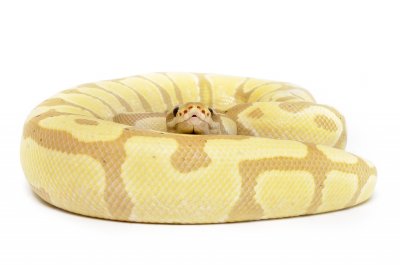
Banana ball pythons are original species which are found in their natural habitat. They are yellow or orange, a trait that makes them morphs. This subspecies is considered a morph since standard pythons (which are not scientifically considered to have mutated) have a predominant brown color.
Other morphs can be acquired from crossbreeding that involve the banana morph. However, some cannot receive its traits even if crossbreeding is done. (This is an interesting area of scientific research).
Offspring of the Banana Ball Python
When the banana constrictor breeds with another of its species, it begets offspring that have unique traits compared to those that come from interbreeding that involves banana and other morphs. The Super Banana, for instance, comes from breeding two banana morphs- a male and a female.
They are even more yellow than their parents due to the strong genetic combination from two banana ball pythons. The yellow or orange skin color is brighter than the parent’s. This explains the reasons for the name; “super banana”.
Other banana ball pythons include the following:
- Banana Albino ball python which is a crossbreed between a Banana Ball python and an Albino.
- Banana Pied Ball python, which is a crossbreed of the banana and the piebald.
- Banana Cinnamon Ball python, which is a crossbreed of a banana and a cinnamon.
Others include the banana lemon ball, banana jigsaw, banana inferno ball, banana ivory ball, banana enchi ball, and banana coral glow ball. All these take both the banana genes and those of their other parent, thereby coming out as unique and interesting morphs. However, banana genes are the most dominant.
2. Albino Ball Python
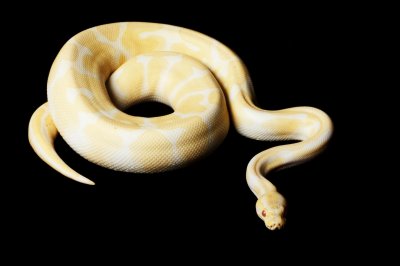
These constrictors are also found in West Africa like most other ball pythons. They are called “albino” due to the lack of melanin pigment in their skin. Their eyes are red or pink in some instances.
The skin color is generally, a combination of white and yellow. However, some of them may lose the white markings with time and transform to fully yellow. These are considered to be the ones with a lesser concentration of albinism. The others retain the white and yellow.
They are among the most valued constrictors and this makes them quite expensive in comparison to other ball pythons. Further, it is generally considered that they are not very difficult to bring up as they mostly feed only once or twice in a fortnight. Provided they are handled with care, albino ball pythons can have a long lifespan.
Because they are one of the most sought after morphs by pet keepers, the breeding of these albino ball pythons is done more carefully to produce the desired morphs. For keepers who prefer breeds with a high contrast of albinism, breeding is selectively restricted to both partners of high contrast.
3. Bumblebee Ball Python
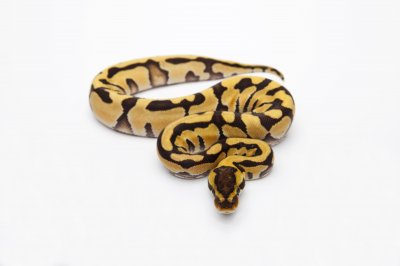
These constrictors are morphs that are as a result of crossbreeding between pastel and spider ball pythons. They are among the most popular types and morphs of ball pythons. Their looks could be deceiving as they appear fierce, but in reality, they are as docile as any other ball python.
These morphs are a special breed that is deliberately made by man and can barely survive in the wild. That is why they are mostly found in zoos and homes of snake pet keepers.
What do they look like?
Bumblebee ball pythons have skin with yellow and black pigmentation. The first impression you would get by looking at it is that of a dangerous snake. They are mean-looking, but they are very friendly. The dominant gene donor is the spider ball python, hence the close resemblance.
Since the breeding that produces the bumblebee is human-controlled, there are features of other ball python morphs that can be seen on the bumblebee.
It is the reason why there are albino bumblebees which are red-eyed with cream-colored skin. Others are born without scales on their skin and hence are given the name “scaleless bumblebee ball python”. More variations of the bumblebee include, but are not limited to:
- Pied bumblebee
- Axanthic bumblebee
- Clown bumblebee
As we have mentioned earlier, a bumblebee is made by crossbreeding a spider ball python and a pastel. This does not mean that any breeding between the two morphs would result into a bumblebee. To achieve a bumblebee, you have to be very specific in breeding. This is done by selecting a super pastel morph to mate with the spider.
A super pastel is one whose parents are both original pastels, so that it gets a strong genetic combination of the same morph. Therefore, not any pastel would yield a bumblebee with a spider.
4. Spider Ball Python
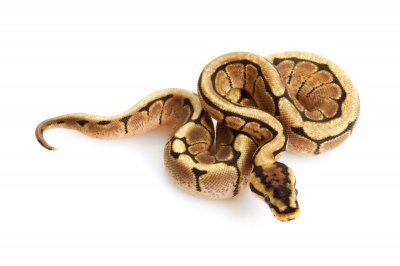
Breeders who specialize in selling ball python pets know the value of the spider ball python. It is one of those morphs that can produce strong genetic combinations when mixed with other morphs. A good example is the bumblebee, as discussed above. It is one of the most popular and highly-priced pets in the market.
These morphs have a genetic condition that affects their heads. It is a neurological condition that causes them to wobble their heads back and forth, causing them confusion and lack of coordination in their activities. This condition is so serious that some people empathize with their condition and recommend that they should not be bred.
Some Features of Spider Ball Pythons
These morphs have some features which are physically distinctive when compared with other subspecies. Here are the features:
- The eyes are green.
- Their skin color appears just like the original (standard ball pythons) brown.
- The black patterns are an exception; however, they are more thinly pigmented than ordinary ball pythons.
- Their bellies and sides are white.
The bad side of the spider ball python is that what causes its head to wobble cannot be cured. Moreover, it is not easy to breed a “super” version of this morph. Most of the reported breeding cases so far show only normal spiders being produced. This sub-species is unlike others such as the banana ball python that produces a super banana morph when it mates with a fellow banana.
5. Pastel Ball Python
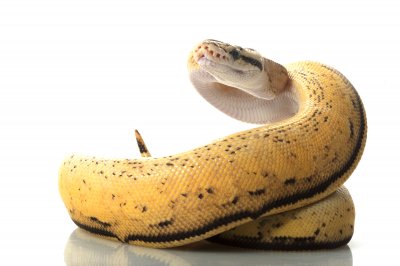
These are green-eyed creatures. Their heads tend to have faded coloration when they are little. They become darker as the snake becomes older. Their bellies are white.
A super pastel breed is more yellow than the others. The skin is not purely yellow, though. It has black patterns. The patterns are generally in black shades.
They are beautiful snakes that breeders use to produce other morphs. Just like we mentioned, the bumblebee is as a result of crossbreeding a super pastel with a spider ball python. Therefore, their prices are high.
Breeders use the pastel to breed other morphs. They pair them with several other morphs to come up with many other morphs that have the same predominant gene as the pastel, especially the “super pastel”.
Breeding of the pastel has produced “super” morphs. These are:
- Lemon Pastel pied.
- Axanthic Pastel.
- Enchi Pastel Yellow belly.
- Lemon Ball Python.
- Mandarin Pastel.
6. Mojave Ball Python
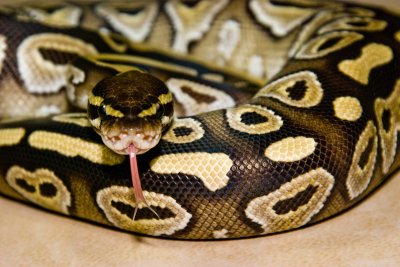
Mojave is a ball python that looks different from other species of the ball python. The skin has the “Mojave pattern”. The coloring is more beautiful compared to an ordinary ball python.
This morph can fetch a very high price compared to just any other ball python. This is probably because they are taken care of in a very good way. Their capacity and ability to breed is very high too.
Generally, they are like other ball pythons in terms of size and length. The unique thing in them is the color and the beautiful pattern on the skin. Also, the fact that they can breed with others and produce many morphs makes them unique.
Different Morphs of Mojave
Here, we do not even mention all the morphs that the Mojave ball python can give rise too. Still, we mention some of the colorful ones to show how Mojaves can be used to create more morphs. Here is a list:
- Albino Mojave.
- Cinnamon Mojave.
- Special Mojave.
- Firefly Mojave.
- Super Mojave.
7. Lesser Ball Python
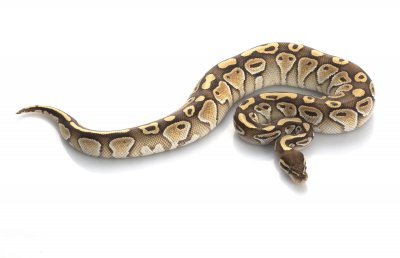
The list of ball python morphs. It has more yellow color on its skin and the pattern is beautiful. It adds more colorful patterns to its morphs. One of the types of morphs that it is used to make is the Blue-Eyed Leucistic.
This is one of the morphs where the males are smaller in size compared to the females. An adult of this morph can be as long as 4-and-a-half feet long.
8. Blue-Eyed Leucistic Ball Python (BEL)
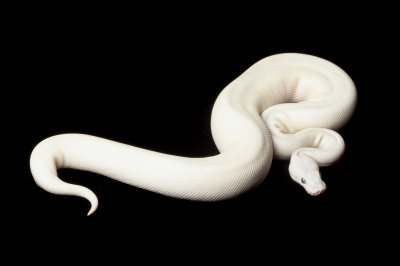
This morph is not easy to find. It is purely white with very beautiful blue eyes. The blue eyes are not a defect in any way. You can think of them as an enhancement to their beautiful appearance.
It is not very easy to make this morph. Even if you interbreed the Mojave, Lesser and Butter morphs, it is not given that the offspring will automatically be a BEL. Other morphs that can create the BEL are Russo and Phantom.
Why the Blue-Eyed Leucistic is Costly
- It is expensive because:
- It is one of the rare morphs which pet-keepers lookout for enthusiastically.
- It is not easy to make.
- Its outstanding beauty is selling itself.
It is ornamental due to its beautiful appearance. The fact that pet keepers often want to keep the best provides a steady market for the breeders who want to make this Blue-Eyed Leucistic Ball Python.
9. Scaleless Ball Python
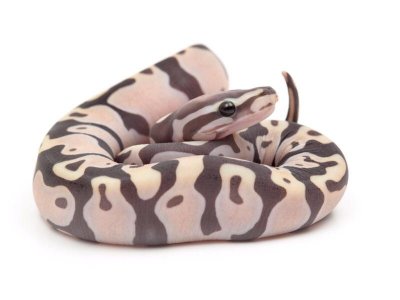
Some enthusiastic breeders have experimented with the scaleless head ball python to make a completely scaleless ball python. Interbreeding two scaleless ball pythons have been proven to give rise to the scaleless subspecies. It is the “super” form of the scaleless heads.
Scaleless heads behalf more like all other ball pythons. So, you may not be quick to notice them. However, when you look at the cloaca, you will find that they have a double scale. The scale seems to be divided by a line in the middle such that they appear to be two.
Making the male and female version mate will make the full version of scaleless ball python whose body only has scales at the belly.
Bottom line
We have seen how the ball python has many morphs. Some of those morphs can be found in their natural habitat which mostly is in West and Central Africa. Further, we have seen that most of the existing morphs are man-made. This means that man purposely selects the morphs of the ball python and interbreeds them.
The reason for the selective breeding is so that there can be more offspring with “super” genetic combinations having acquired them from strong donors who are carefully selected to mate.
References and further reading:
- Kevin McCurley. (2014). The Ultimate Ball Python: Morph Maker Guide. Retrieved from amazon.com
- Philippe De Vosjoli and Roger Klingenberg. (2004). The Ball Python Manual. Retrieved from amazon.com
- vmsherp.com. How To Breed Ball Pythons
- Markus Jayne. Ball PythonsBreeding